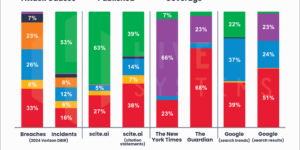A study published by the Washington State Department of Natural Resources last week shows a tsunami triggered by a major earthquake beneath Puget Sound would arrive at Seattle shores sooner and reach farther inland than previously thought.
Models showed a tsunami following a magnitude 7.5 quake would inundate Seattle’s shoreline under more than 20 feet (6.1 meters) of water, and reach parts of Bainbridge Island, Elliott Bay and Alki Point within three minutes, The Seattle Times reported.
Waves could reach a staggering 42 feet (12.8 meters) at the Seattle Great Wheel downtown and reach as far as Lumen Field and T-Mobile Park.
“Three to five minutes is all that separates a seismic event from the arrival of tsunami waves,” Public Lands Commissioner Hilary Franz said Thursday during a news conference on the Seattle waterfront. “Which is why we do this research now so everyone is aware of it, so our local state government is aware of it, and we can start to prepare and plan and take all precautions necessary.”
The new study used newer data on topography and elevation, spanning a larger area, than previous studies of the Seattle, Tacoma and Everett areas published in 2003, 2009 and 2014.
While Tacoma is projected to see less water inundation than in previous studies, the new report said waves could travel farther inland.
North of Deception Pass, the waves grow smaller, to a projected average height of 5 feet (1.5 meters).
Franz urged residents to learn more about the risks in their area, sign up for earthquake and tsunami warnings, and to prepare an emergency kit with at least two weeks of water, food and other necessities—and to do all of that now.
In the study, researchers from the department’s Washington Geological Survey division used projections modeled after the last major earthquake under the Seattle fault— a magnitude 7.5 about 11,000 years ago—to estimate the height, arrival time and inland reach of a subsequent tsunami if, or when, the disaster repeats itself.
Research shows the fault has triggered smaller quakes, mostly around 6.5 magnitude, five times in the past 3,500 years.
The quake that happened 11,000 years ago was likely the biggest in the past 16,000 years.
While it’s likely future earthquakes will be smaller than what was modeled, the projections were still “shocking,” said Alex Dolcimascolo of the Geological Survey division, an author of the report. “We really wanted to emphasize this scenario so people can prepare.”





















 Auto Insurer Files $450M Fraud RICO Case in NY
Auto Insurer Files $450M Fraud RICO Case in NY  RiverStone International to Provide Loss Portfolio Transfer for Zurich Insurance
RiverStone International to Provide Loss Portfolio Transfer for Zurich Insurance  Dear Elon and Vivek: Insurance Commissioners Urge DOGE to Ditch FIO
Dear Elon and Vivek: Insurance Commissioners Urge DOGE to Ditch FIO  Soft Market Ahead? The Role of Digital Transformation for E&S Insurers
Soft Market Ahead? The Role of Digital Transformation for E&S Insurers 